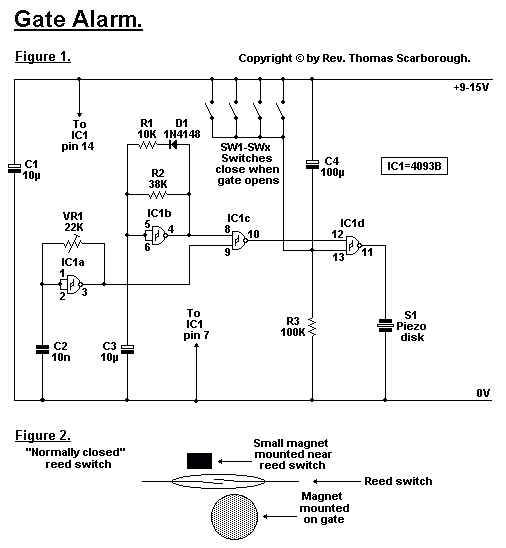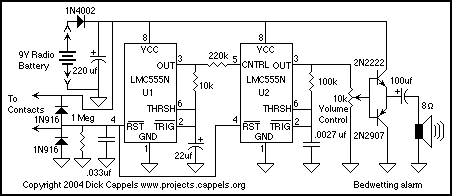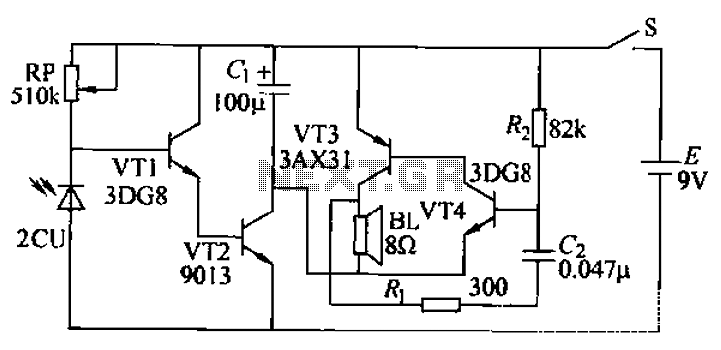
Fridge Alarm with 4060

This circuit, enclosed into a small box, is placed in the fridge near the lamp (if any) or the opening. With the door closed the interior of the fridge is in the dark, the photo resistor R2 presents a high resistance (>200K) thus clamping IC1 by holding pin 12 high. When a beam of light enters from the opening, or the fridge lamp illuminates, the photo resistor lowers its resistance (<2K), pin 12 goes low, IC1 starts counting and, after a preset delay (20 seconds in this case) the piezo sounder beeps for 20 sec.
The described circuit functions as a light-activated timer and alarm system specifically designed for installation within a refrigerator. The core components include a photoresistor (R2), an integrated circuit (IC1), and a piezo sounder, all housed within a compact enclosure.
When the refrigerator door is closed, the internal environment remains dark. Under these conditions, the photoresistor R2 exhibits a high resistance, exceeding 200kΩ. This high resistance prevents current flow through R2, thereby keeping pin 12 of IC1 in a high state. Consequently, IC1 remains inactive, ensuring that the piezo sounder does not emit any sound.
Upon opening the refrigerator door, ambient light enters the compartment, causing the resistance of R2 to drop significantly, falling below 2kΩ. This change in resistance allows current to pass through R2, which pulls pin 12 of IC1 low. The transition from high to low triggers IC1 to commence its timing sequence.
IC1 is configured to count for a predetermined duration, which is set to 20 seconds in this application. After this interval elapses, IC1 activates the piezo sounder. The sounder emits a series of beeps lasting for 20 seconds, serving as an auditory alert. This feature is particularly beneficial for preventing the refrigerator door from being inadvertently left open, which could lead to energy loss and spoilage of food items.
Additional considerations for this circuit design include the selection of the photoresistor, which should be sensitive enough to detect typical indoor lighting conditions, and the choice of IC1 to ensure that it has the necessary timing capabilities and output drive strength to activate the piezo sounder effectively. Power supply requirements should also be taken into account to ensure reliable operation within the refrigerator environment.This circuit, enclosed into a small box, is placed in the fridge near the lamp (if any) or the opening. With the door closed the interior of the fridge is in the dark, the photo resistor R2 presents a high resistance (>200K) thus clamping IC1 by holding pin 12 high.
When a beam of light enters from the opening, or the fridge lamp illuminates, the photo resistor lowers its resistance (<2K), pin 12 goes low, IC1 starts counting and, after a preset delay (20 seconds in this case) the piezo sounder beeps for 20 sec. t 🔗 External reference
The described circuit functions as a light-activated timer and alarm system specifically designed for installation within a refrigerator. The core components include a photoresistor (R2), an integrated circuit (IC1), and a piezo sounder, all housed within a compact enclosure.
When the refrigerator door is closed, the internal environment remains dark. Under these conditions, the photoresistor R2 exhibits a high resistance, exceeding 200kΩ. This high resistance prevents current flow through R2, thereby keeping pin 12 of IC1 in a high state. Consequently, IC1 remains inactive, ensuring that the piezo sounder does not emit any sound.
Upon opening the refrigerator door, ambient light enters the compartment, causing the resistance of R2 to drop significantly, falling below 2kΩ. This change in resistance allows current to pass through R2, which pulls pin 12 of IC1 low. The transition from high to low triggers IC1 to commence its timing sequence.
IC1 is configured to count for a predetermined duration, which is set to 20 seconds in this application. After this interval elapses, IC1 activates the piezo sounder. The sounder emits a series of beeps lasting for 20 seconds, serving as an auditory alert. This feature is particularly beneficial for preventing the refrigerator door from being inadvertently left open, which could lead to energy loss and spoilage of food items.
Additional considerations for this circuit design include the selection of the photoresistor, which should be sensitive enough to detect typical indoor lighting conditions, and the choice of IC1 to ensure that it has the necessary timing capabilities and output drive strength to activate the piezo sounder effectively. Power supply requirements should also be taken into account to ensure reliable operation within the refrigerator environment.This circuit, enclosed into a small box, is placed in the fridge near the lamp (if any) or the opening. With the door closed the interior of the fridge is in the dark, the photo resistor R2 presents a high resistance (>200K) thus clamping IC1 by holding pin 12 high.
When a beam of light enters from the opening, or the fridge lamp illuminates, the photo resistor lowers its resistance (<2K), pin 12 goes low, IC1 starts counting and, after a preset delay (20 seconds in this case) the piezo sounder beeps for 20 sec. t 🔗 External reference





